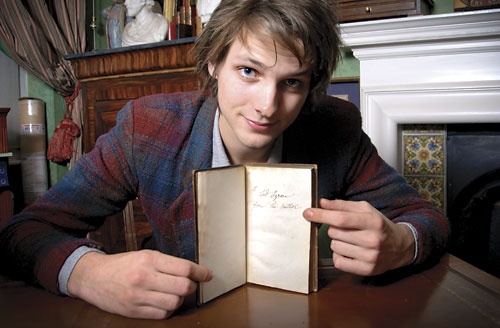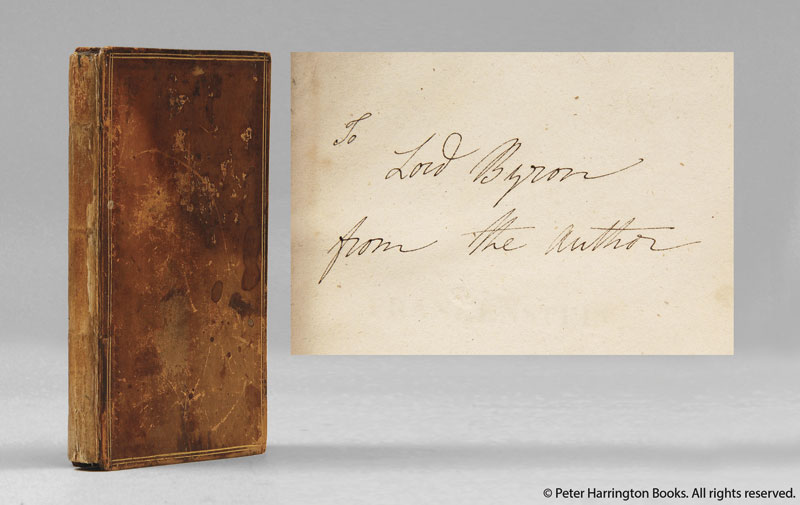Presenting Frankenstein, Risen From the Dead
A London man finds the second-known inscribed copy of Mary Shelley’s masterpiece on his grandfather’s shelves By Jonathan ShipleyJonathan Shipley is a freelance writer based in Seattle who collects modern first editions and his daughter’s drawings that cover the walls of his writing space. His work has appeared in the Los Angeles Times, Lexus Magazine, Diner Journal, and many other publications.

It was a dark and stormy night. It was, truly, that evening in June 1816 on the shores of Lake Geneva at the Villa Diodati. It was there that a ghost story–writing contest was had. The participants? Lord Byron, Byron’s physician, Polidori, Percy Shelley and his love, Mary Shelley, not yet nineteen years of age. Over the roar of a fire and pattering rain, they read German ghost stories and discussed the works of Erasmus Darwin, an English physician who was rumored to have animated dead matter.
And it came to her. To Mary Shelley, a character formed—a grotesque creature. She wrote his tale of woe. “Frightful must it be;” she wrote, “for supremely frightful would be the effect of any human endeavor to mock the stupendous mechanism of the Creator of the world.” Frankenstein was born. Issued anonymously in 1818, only five hundred copies were printed. Of those, perhaps twenty-five were inscribed by the author, and of those, only two survive. One is at the Morgan Library & Museum in New York City. The other, unbeknownst to everyone, was sitting on a shelf among the papers of the late Douglas Jay, a British Labour Party politician during the 1960s.
“In the deeply unemployed winter of last year,” said Sammy Jay, the twenty-three-year-old grandson of Douglas Jay, “my step-grandmother Mary had kindly given me an occupation in sorting through my late grandfather’s political papers for Oxford’s Bodleian Library archives.” With an interest in Romantic literature, Douglas Jay had collected, as Sammy said, “plenty of musty stuff from the nineteenth century.” Wordsworth, Tennyson, and Dickens lined the shelves of Douglas Jay’s library, as well as works by his contemporaries. There were some nice copies of books presented to him by poets like Louis MacNeice, Stephen Spender, and Cecil Day-Lewis. “Nothing at all,” Jay continued, “could have prepared me for the little volume lying at an angle in the corner of the top shelf.” He almost passed it over but instead grabbed it and flipped it open. Inside was an inscription – “To Lord Byron, from the author.”
“It took me awhile to adjust to the magnitude of the find,” said Jay.
Sammy Jay is a bibliophile in his own right who collects Romantic association copies and ephemera and is now employed at Peter Harrington Rare Books in London. So he knew what to do: he took the book to Richard Ovenden, deputy librarian at the Bodleian Libraries, to authenticate Mary Shelley’s signature. Ovenden was positive.
Soon after, Douglas Jay’s widow, Mary, decided to release it to the world and sell it at auction. Peter Harrington Rare Books was in charge of its sale and offered, for a time, to display the book to the public at its shop in London this past autumn. It was, said Peter Harrington’s proprietor Pom Harrington, “a wonderful opportunity to share the association copy and perhaps the most evocative presentation copy conceivable in all nineteenth-century literature with the world.”
The book has since sold. The asking price had been £350,000 ($567,000), but what it ultimately went for is confidential. Sammy Jay said, “The only details I can give on the sale are that it has gone to a buyer within the United Kingdom and that the buyer will be allowing it to be shown in public exhibitions and institutions.”








